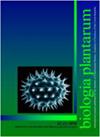Genome-wide identification of the PYL gene family and expression of PYL genes under abiotic stresses in Chinese cabbage
IF 0.9
4区 生物学
Q4 PLANT SCIENCES
引用次数: 0
Abstract
The family of pyrabactin resistance 1 (PYR1)/PYR1-like (PYL) regulatory components of ABA receptors (RCAR) play a vital role in the initial step of ABA signaling. To understand the expression mode of PYL genes in response to various abiotic stresses in Chinese cabbage ( Brassica rapa ssp. pekinensis ), the members of BrPYL gene family were first identified with the relevant bioinformatics software. And then, the relative expressions of identified BrPYLs after heat, cold, drought, and salt treatments for 0, 24, 48, and 72 h were determined via real-time quantitative PCR. Here, we identified 24 PYLs in the B. rapa genome. Based on the phylogenetic analysis, these BrPYL genes were divided into three classes and distributed on ten chromosomes in Chinese cabbage. Most of BrPYL genes in the same group have similar gene structures and intron numbers. There were seven genes ( BrPYL 5, BrPYL8 , BrPYL22 , BrPYL3 , BrPYL18 , BrPYL11 , and BrPYL21 ) from Group A with two introns and one gene ( BrPYL19 ) from Group D with one intron. Analysis of conserved motifs suggested that every group contained motif 2 containing the Polyketide_cyc2 domain. Subsequently, the prediction of cis -acting elements indicated that BrPYL genes had 5 stress-related elements and 5 hormone-related elements, among which the number of MYC (dehydration reaction) was the highest, suggesting that BrPYL genes could respond to hormones and abiotic stresses. Expression patterns under four abiotic stresses showed that the expressions of BrPYL4 , BrPYL11 , BrPYL21 , and BrPYL23 responded to these stresses at different time points. To conclude, we identified the BrPYL genes and build the BrPYLs expression mode in response to various abiotic stresses. This study provides a theoretical basis for stress-resistance breeding of Chinese cabbage.白菜PYL基因家族的全基因组鉴定及PYL基因在非生物胁迫下的表达
pyrabactin resistance 1 (PYR1)/PYR1-like (PYL)调控组分ABA受体(RCAR)家族在ABA信号传导的初始阶段起着至关重要的作用。了解PYL基因在不同非生物胁迫下的表达模式。利用相关生物信息学软件首次鉴定出BrPYL基因家族成员。然后,通过实时荧光定量PCR测定鉴定出的brpyl在热、冷、旱、盐处理0、24、48和72 h后的相对表达量。在这里,我们在rapa基因组中鉴定了24个pyl。通过系统发育分析,将这些BrPYL基因分为3类,分布在白菜的10条染色体上。同一类群中大多数BrPYL基因具有相似的基因结构和内含子数量。A组有7个基因(brpyl5、BrPYL8、BrPYL22、BrPYL3、BrPYL18、BrPYL11和BrPYL21)含有2个内含子,D组有1个基因(BrPYL19)含有1个内含子。保守基序分析表明,每一组都含有含有Polyketide_cyc2结构域的基序2。随后对顺式作用元件的预测表明,BrPYL基因有5个应激相关元件和5个激素相关元件,其中MYC(脱水反应)的数量最多,表明BrPYL基因能够响应激素和非生物胁迫。4种非生物胁迫下的表达模式显示,BrPYL4、BrPYL11、BrPYL21和BrPYL23的表达在不同时间点对这些胁迫有响应。综上所述,我们鉴定了BrPYL基因,并建立了BrPYL在各种非生物胁迫下的表达模式。本研究为大白菜抗逆性育种提供了理论依据。
本文章由计算机程序翻译,如有差异,请以英文原文为准。
求助全文
约1分钟内获得全文
求助全文
来源期刊

Biologia Plantarum
生物-植物科学
CiteScore
2.80
自引率
0.00%
发文量
28
审稿时长
3.3 months
期刊介绍:
BIOLOGIA PLANTARUM is an international journal for experimental botany. It publishes original scientific papers and brief communications, reviews on specialized topics, and book reviews in plant physiology, plant biochemistry and biophysics, physiological anatomy, ecophysiology, genetics, molecular biology, cell biology, evolution, and pathophysiology. All papers should contribute substantially to the current level of plant science and combine originality with a potential general interest. The journal focuses on model and crop plants, as well as on under-investigated species.
 求助内容:
求助内容: 应助结果提醒方式:
应助结果提醒方式:


